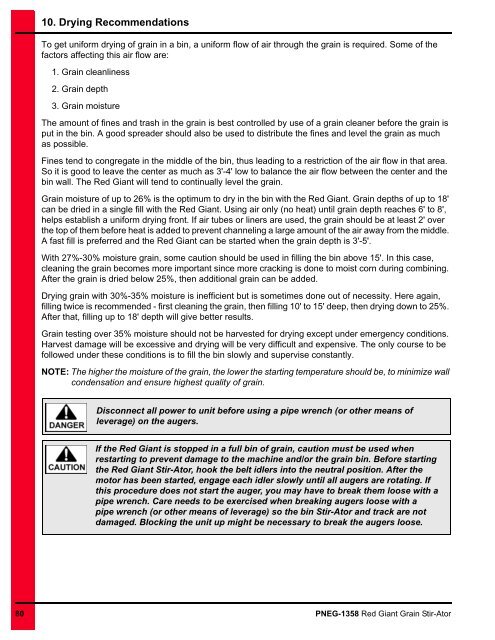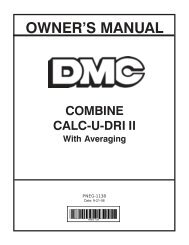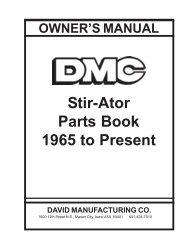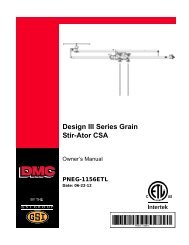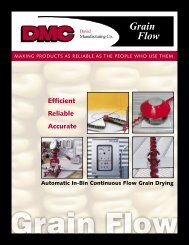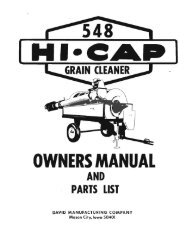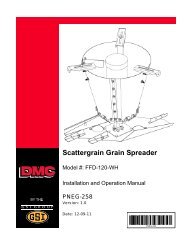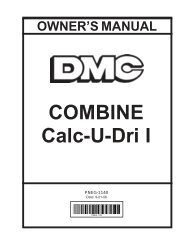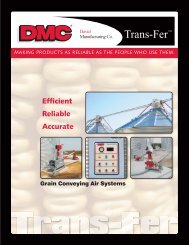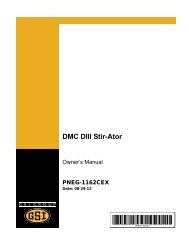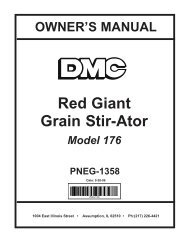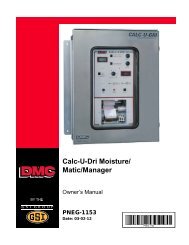Red Giant Grain Stir-Ator - David Manufacturing Co.
Red Giant Grain Stir-Ator - David Manufacturing Co.
Red Giant Grain Stir-Ator - David Manufacturing Co.
- No tags were found...
Create successful ePaper yourself
Turn your PDF publications into a flip-book with our unique Google optimized e-Paper software.
10. Drying RecommendationsTo get uniform drying of grain in a bin, a uniform flow of air through the grain is required. Some of thefactors affecting this air flow are:1. <strong>Grain</strong> cleanliness2. <strong>Grain</strong> depth3. <strong>Grain</strong> moistureThe amount of fines and trash in the grain is best controlled by use of a grain cleaner before the grain isput in the bin. A good spreader should also be used to distribute the fines and level the grain as muchas possible.Fines tend to congregate in the middle of the bin, thus leading to a restriction of the air flow in that area.So it is good to leave the center as much as 3'-4' low to balance the air flow between the center and thebin wall. The <strong>Red</strong> <strong>Giant</strong> will tend to continually level the grain.<strong>Grain</strong> moisture of up to 26% is the optimum to dry in the bin with the <strong>Red</strong> <strong>Giant</strong>. <strong>Grain</strong> depths of up to 18'can be dried in a single fill with the <strong>Red</strong> <strong>Giant</strong>. Using air only (no heat) until grain depth reaches 6' to 8',helps establish a uniform drying front. If air tubes or liners are used, the grain should be at least 2' overthe top of them before heat is added to prevent channeling a large amount of the air away from the middle.A fast fill is preferred and the <strong>Red</strong> <strong>Giant</strong> can be started when the grain depth is 3'-5'.With 27%-30% moisture grain, some caution should be used in filling the bin above 15'. In this case,cleaning the grain becomes more important since more cracking is done to moist corn during combining.After the grain is dried below 25%, then additional grain can be added.Drying grain with 30%-35% moisture is inefficient but is sometimes done out of necessity. Here again,filling twice is recommended - first cleaning the grain, then filling 10' to 15' deep, then drying down to 25%.After that, filling up to 18' depth will give better results.<strong>Grain</strong> testing over 35% moisture should not be harvested for drying except under emergency conditions.Harvest damage will be excessive and drying will be very difficult and expensive. The only course to befollowed under these conditions is to fill the bin slowly and supervise constantly.NOTE: The higher the moisture of the grain, the lower the starting temperature should be, to minimize wallcondensation and ensure highest quality of grain.Disconnect all power to unit before using a pipe wrench (or other means ofleverage) on the augers.If the <strong>Red</strong> <strong>Giant</strong> is stopped in a full bin of grain, caution must be used whenrestarting to prevent damage to the machine and/or the grain bin. Before startingthe <strong>Red</strong> <strong>Giant</strong> <strong>Stir</strong>-<strong>Ator</strong>, hook the belt idlers into the neutral position. After themotor has been started, engage each idler slowly until all augers are rotating. Ifthis procedure does not start the auger, you may have to break them loose with apipe wrench. Care needs to be exercised when breaking augers loose with apipe wrench (or other means of leverage) so the bin <strong>Stir</strong>-<strong>Ator</strong> and track are notdamaged. Blocking the unit up might be necessary to break the augers loose.80 PNEG-1358 <strong>Red</strong> <strong>Giant</strong> <strong>Grain</strong> <strong>Stir</strong>-<strong>Ator</strong>


